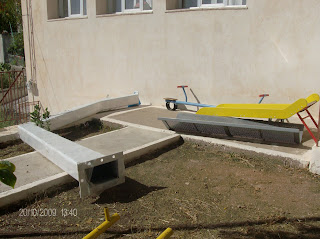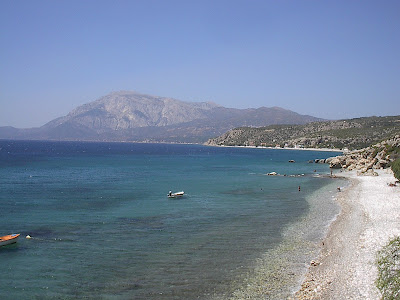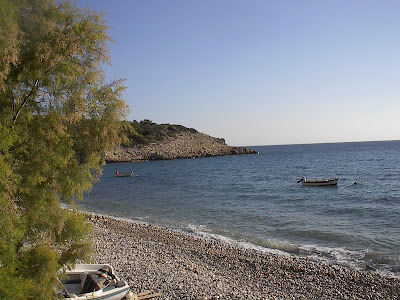
A second and most devastating forest fire broke out on 6 July 2000 at 7:30 p.m. on Samos Island (Greece). Multiple fires were spreading and covered a big area of far more than 2500 ha. These were only rough estimations. The official figures are strongly differing from each other. The forest department talked about 4000 ha, the agricultural department estimated about 2400 ha burned. Fact is that due to strong winds of 6 - 8 Beaufort from shifting directions the fire fighting operations were made extremely difficult, while fire fighters were facing flames of up to 70 meters high and a huge thermal radiation which lead to a high velocity of the fire transportation over the island.
On 10 July the state brigades with a total of 520 firemen and 60 fire engines, supported by 5 air fire fighting vehicles (3x M26 helicopters and 2x C130 air-planes) were fighting against the fires to save lives and possessions of the inhabitants of Samos Island as well as to put an end to the destruction of the almost virgin biosphere of thousands of species of plants and animals.
Two monasteries dated before the year 1500 BC and parts of 5 villages are victims of the fires. Although it is remarkable that there are no human victims apart from one 92 years old lady which decided to return into her burning house to take something out. The burning down of the electricity grid led to an interruption in the power supply for a few days, affecting the whole western parts of Samos and the Fourni Island Group which is connected to Samos Island via sea cable.
Tourists were awaited to massively leave the Island and others, who planned their vacations on Samos, to cancel their bookings, which was avoided by the tour operators who immediately informed themselves about the situation for the tourism and concluded that there is no danger for the tourists and the holidays at the shore area are not influenced much. The tour operators on the one hand immediately offered alternatives to their clients interested in nature related tourism an on the other hand have made an attempt to offer some help to the burned Island. Samos is one of most prominent tourist resorts in the Northern Aegean, receiving more than 300.000 Tourists from charter packages every season.
The situation seems to show that damage the fires caused – directly and indirectly - to the local economy is very big. The ecology is extremely damaged.
On the morning of 11 July estimates called out the year 2000 as the most harmful to the ecosystems of Samos, leaving the main parts of the forested area on Samos destroyed. Local authorities fear that the inhabitants especially the young people will start to leave Samos after this catastrophe.
Although on 11 July the winds calmed down and most fires seemed almost under control one had to realise soon that this was a very weak stabilisation because any weather change and cases of re-ignition may have led to further catastrophes. This proofed especially true when considering the fact that the state brigades partially had to leave the Island.
On 12 July the winds regained force and the fires were burning again, leading to the continuation of the disaster. The German Embassy signalled the preparedness to initiate some emergency help by the German Armed Forces Bundeswehr and the Federal German Agency for Technical Assistance (Technisches Hilfswerk - THW) immediately. The prerequisite for such a help was that the Greek Minister for Public Order, Mr. Chryssochoidis, would sent an official request for help to the German Embassy. The Minister so far officially only had asked France and Italy (as far as we are informed) who faced the same problems as Greece and thus were not able to help. A personal contact via telephone the same morning had been used by GSDP to inform the Minister about the situation and the preparedness of the German Embassy. We were than expecting for the official letter to the German Embassy sent by the Minister. After only 5 hours first help from Germany could have arrived – if requested.
On Thursday evening 15 July 2000 the prime minister Mr. Simitis and the minister Chryssochoidis announced in the parliament that they would immediately ask Germany and Scandinavian countries as well as Israel and the Czech Republic for help. Germany should especially help in preparing the post fire measures.
This led the whole apparatus start on Friday 16 July again including GSDP and the private sponsors. Meanwhile we received a few essential mails with offers of help from international private companies. The networking and co-ordination of the private sectors help (technically, organisationwise and economically) with the international fire fighting brigades and the Greek States Forces would surely have been of significance and essential in order to minimise the damages on Samos. But in the afternoon of the same day the Greek government withdrew its help call towards Germany because they estimated to control the situation, so the whole action had been freezed.
The main essential thing now, is the management of the days after the fire catastrophe, because after a fire catastrophe the ecological catastrophe (e.g., soil erosion) can be ultimately more devastating than the fire itself (Samos has enormous slope decline degrees which could be frame conditions for quick soil erosion).
It is necessary to act and to organise an emergency task force help for Samos which will have positive influences directly on the local situation. Many isolated activities have been initiated and are about to start. But they will be much more effective for the Islands redevelopment, when a co-ordination of all the activities will be taken over from one entity comprised of representatives of the Prefecture, the Municipalities Association, local and foreign privates, such as experienced individuals, associations, companies.
Gerling SDP has developed a plan for the Sustainable Development of the Prefecture of Samos. A two-years programme will especially be concerned about the catastrophe and initiate direct help in form of technical, organisational and financial support to Samos.
Immediate activities
We start with an initial budget of 100,000 DM with the aim to achieve a series of immediate fund-raisings for the purpose of sending specialists and material in the form of specialised extinguishing products for forest fires to be applied in consultation with international specialists to extinguish new arising fires more effectively and to keep the fire sources that are extinguished under control hence the state fire brigades have left the Island. The main target is to save the rest of the existing forest areas.
In the next two weeks different people involved in help measures should meet physically on Samos to found and start up the special task force described above to co-ordinate all activities ongoing.
Immediately the foundation of a local fire fighting troop staffed with volunteers should be planned and organised to be realised as soon as possible. It should include a fire fighting school for all people of Samos interested. The people should be parted into three groups.
All interested people living on Samos or spending long time periods on Samos to be trained in the right behaviour in case of fires especially forest fires,
People who have other jobs on Samos but would like to join a volunteer Fire fighting group to be trained on fighting fires especially forest fires with all available measures
People who would spent much time on being specially trained on fire fighting measures and strategies in case of forest fires and who will have access to all information in case of forest fires to be the chain link between the state fire brigades and the Samian fire fighting forces for an optimal co-ordination of the fire fighting efforts
The school could be situated together with the centre of the fire fighting troop in which all facilities for fire fighting that can be organised through sponsoring, financed by the region or state government or other sources will be concentrated and all material will be stored. This facility could also be the fire fighting headquarter due to the fact that it would be equipped with the communication measures needed.
Finally, on a medium-term scale, immediate activities to minimise the soil erosion following a forest fire of this extent are of crucial necessity.
Necessary medium term measures
In the medium-term it must also be achieved to set up an organisation for the precaution of such natural catastrophes with quick identification and response systems and technologies. This has to be done with the support and use of technologies like Geo Information Systems (GIS) using earth observation data from satellites.
A fully integrated approach to the technical and organisational fire protection includes:-
the organisation of fire watches,
detailed emergency response plans,
investment plans for technical equipment and training for
a) special response forces,
b) volunteer task forces and
c) the whole population of Samos for the right response in case of forest fires
The mass of partially or fully burned wood should be recycled and subsequently give jobs to some of the people that were hit hardest by the fires, having lost their fields, olive trees, vineyards, bee stocks and so on. The priority of installing a biomass treatment installation (already identified in May) may now be a necessary and helpful step to rehabilitate the former forest grounds.
Volunteers from Greece and around Europe may be involved in the actual replanting of the trees and other immediate actions needed to rehabilitate the whole area. Apart from actually working with the local people on the rehabilitation, the volunteers would get to know the island of Samos and establish long-term relationships with the local people (some of them will definitely come back in the years to come to see the result of their work). They will also provide some financial support to the local economy through their consumption during their presence and this will be highly appreciated, considering the disaster for the local tourism.
The local population has for obvious reasons an interest in the rehabilitation of the area. They may collaborate with the volunteers and also provide them with housing (local families may host these people coming from abroad for a period of one to two weeks as long as their presence on the island is needed).
The tour operators (TUI, etc.) should sponsor the activities either with cash or through their network of agencies across Europe. In any case it is in their interest to rehabilitate the island as soon as possible and in all cases it can be a good publicity to show to their clients that they really care for the places where they go (corporate social responsibility).
Various international and national environmental organizations (WWF, etc.) should disseminate the information about the objectives of the actions taken and actively participate either as volunteers or as providers of knowledge on current good practice.
Fire experts and forest researchers should define the best way to reestablish the forest (type of vegetation, definition of anti- fire zones, etc.)
The Greek authorities should back the whole process by providing the legal framework and the policy measures necessary to assure that the former forest grounds will be kept as forest areas in the future. (Source of the bullets: Stylianos Loupasis)
Call for immediate help
We call for immediate, unbureaucratic and swift support for the immediate activities described in this paper and for the declaration for the support of the following necessary medium term measures. We thank all readers of this for their active support and the dissemination of this appeal.
List of needed material and help
(1) Equipment for the volunteer troops:
Chainsaws with all protective and spare equipment
Wireless communication means
Fire fighting cloths for the volunteer troops
Special footwear for the volunteer troops
Fire engines that are able to go off road (4x4) and are not too heavy
Off road cars (4x4) for the fire watches to guarantee direct access to starting forest fires.
Special fire fighting products for forest fires to be mixed with water
Thermal cameras to identify heat sources that lead to ignitions and reignitions
(2) Money for the following projects:
Biomass driven turbogenerator capable of using burned wood and producing 1 MW of electric power - Estimated full cost for a 9 month project: 2.8 Mio Euro
Biomass processing plant being situated together with project a) to process biomass (incl. organic rests out of forests and agricultural uses, organic wastes and others) Estimated cost: 0.5 Mio Euro
Geographic Information System Project to built a GIS Data base to assess the damages and plan the revitalisation as well as to plan the emergency response based on plans including information about the roads and walks leading to different points of the island as well as their geomorphology (slope degrees) and the local micro climate conditions at the moment a fire starts. Estimated costs: 0.5 Mio Euro for the full GIS Data base for the Samos Prefecture
A scientific and practically holistic rehabilitation study for the Samian forests including proposals for the right management of the forests after the reforestation as well as the right protection measures
List of organisations offering their help:
Daimler-Chrysler Astrium AG, Freiburg D Draeger AG, Neuss D3M Hellas, Athens GRGerling-Konzern AG, Koeln DSafe-Tec GmbH, Neuss DAndreas Stihl A.E., Athens GRStockhausen, Neuss DTUI AG, Hannover D
Contact Address:
Mr. Georgios RadoglouSenior Project Manager - GSDPGerling Sustainable Development GmbHRepresentative Office Athens
Tel: ++30 - 1 – 7259 – 181 (dir.: -282)Fax: ++30 - 1 – 7259 – 005e-mail: george.radoglou@gerling.com
 Κάλεσμα των ζωόφιλων σε διαμαρτυρία για το κυνήγι
Κάλεσμα των ζωόφιλων σε διαμαρτυρία για το κυνήγι





















































